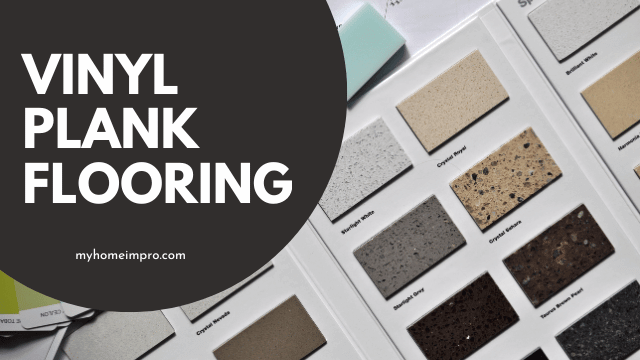Are you looking to enhance your home with vinyl plank flooring? Understanding the nuances of this popular flooring material is key to making an informed decision. Vinyl plank flooring has revolutionized interior design with its design and durability.
This comprehensive guide delves into the essential factors to consider when buying vinyl plank flooring so your choice aligns with your design preferences and lifestyle needs.
Let’s get started.
What to Consider When Buying Vinyl Flooring
Table of Contents
When you buy new flooring, you need to understand the material. To that end, here are some things to consider when choosing vinyl plank flooring. Let’s explore the correlation between LVT (luxury vinyl tiles), vinyl plank and tile flooring moving forward.
What are luxury vinyl, vinyl plank, and vinyl tile flooring?
Luxury vinyl flooring is a broad category of flooring under which vinyl plank and tile fall. This resilient flooring mimics the appearance of natural materials like wood (when in plank form) as well as stone or ceramic tiles.
Vinyl plank flooring replicates the look of hardwood planks. It is a popular choice for those who want the aesthetic of wood without the maintenance challenges.
Vinyl tile replicates the look of ceramic or stone and is a cost-effective alternative to natural tiles with added benefits.
Now that you know each one, let’s move on to the things you need to know before you invest in vinyl plank flooring.
1.Material Composition
Vinyl plank flooring consists of several layers. The wear layer is the topmost one and protects the floor against scratches and stains. The printed design layer provides the flooring’s visual appearance, mimicking wood or other materials. For instance, you will be able to find oak vinyl plank flooring that flawlessly mimics real solid oak flooring.
The core layer gives the plank its structure and thickness, while the backing layer adds stability and moisture resistance. Choosing planks with a thick wear layer is essential, as it determines how well the flooring can withstand daily wear and tear, ensuring durability and a longer lifespan.
2.Thickness Matters
The thickness of vinyl planks is a key indicator of their quality and durability. Thicker planks are generally more robust, making them resistant to dents and damage. Additionally, thicker flooring can contribute to better sound insulation, reducing noise transmission between floors.
When selecting vinyl planks, opt for a thickness that aligns with your specific needs and the level of foot traffic in the area where they are to be installed. The right flooring is only chosen after considering the area of installation and your lifestyle choices.
3.Installation Method
Vinyl plank flooring offers various installation methods. Click-and-lock systems have interlocking edges that snap together, making them suitable for DIY projects. Glue-down options involve adhering the planks directly to the subfloor, providing a more permanent and secure installation. Loose lay methods lay the planks without adhesive, which is suitable for temporary installations. Consider your skill level, time constraints, and preferences when choosing an installation method.
4.Subfloor Condition
The condition of the subfloor is crucial for a successful vinyl plank installation. Whether installed over concrete, plywood, or existing flooring, the subfloor must be clean, level, and free of moisture. Any imperfections or irregularities can affect the appearance and performance of your vinyl flooring. Proper subfloor preparation is essential to prevent issues like warping, buckling, or the growth of mould and mildew beneath the vinyl planks.
5.Water Resistance
Vinyl plank flooring is known for its water resistance, but not all products are entirely waterproof. If you plan to install vinyl planks in areas prone to moisture, such as your kitchen or bathroom, look for products specifically labelled as waterproof.
Waterproof vinyl is designed to resist water absorption, preventing damage and ensuring the longevity of the flooring in humid or wet environments.
6.Underlayment Consideration
Some vinyl plank flooring products require underlayment for additional benefits such as cushioning, noise reduction, and moisture protection. The underlayment provides a buffer between the vinyl planks and the subfloor, enhancing comfort underfoot and reducing sound transmission.
Always check the manufacturer recommendations for the specific product you are considering. This will ensure that you choose the appropriate underlayment that complements the flooring’s characteristics.
7.Warranty and Reviews
Before finalizing your purchase, take the time to read product reviews and investigate the warranty offered by the manufacturer. A solid warranty reflects the manufacturer’s confidence in the durability and performance of their product.
Reviews from other customers also provide real-world insights into the vinyl plank flooring’s quality, installation process, and long-term satisfaction.
Combining warranty information with customer reviews can help you make an informed decision and choose a product that meets your expectations.
Armed with the knowledge of these seven key considerations, you are now well-equipped to embark on your vinyl plank flooring journey. Make sure you take your time and search for the right options for your space. Also, use the right flooring maintenance to keep your flooring looking new for years to come. Need high-quality vinyl plank flooring? Visit your nearest home renovation store.

